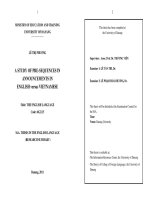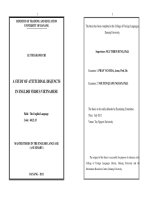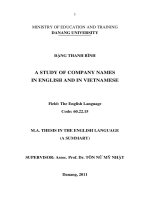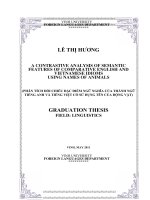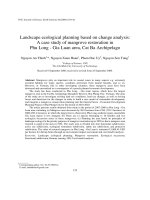study of the undrained static response of sandy soils in the critical state framework
Bạn đang xem bản rút gọn của tài liệu. Xem và tải ngay bản đầy đủ của tài liệu tại đây (3.67 MB, 248 trang )
PURDUE UNIVERSITY
GRADUATE SCHOOL
Thesis Acceptance
This is to certify that the thesis prepared
By
Entitled
Complies with University regulations and meets the standards of the Graduate School for originality
and quality
Forthedegreeof
Final examining committee members
, Chair
Approved by Major Professor(s):
Approved by Head of Graduate Program:
Date of Graduate Program Head's Approval:
Tejas Gorur S. Murthy
Study of the Undrained Static Response of Sandy Soils in the Critical State
Framework
Doctor of Philosophy
Monica Prezzi Co-Chair
Rodrigo Salgado Co-Chair
Adolph G. Altschaeffl
Laura J. Pyrak-Nolte
July 26, 2006
Monica Prezzi
Rodrigo Salgado
Darcy M. Bullock
STUDY OF THE UNDRAINED STATIC
RESPONSE OF SANDY SOILS IN THE
CRITICAL STATE FRAMEWORK
A Dissertation
Submitted to the Faculty
of
Purdue University
by
Tejas Gorur S Murthy
In Partial Fulfillment of the
Requirements for the Degree
of
Doctor of Philosophy
August 2006
Purdue University
West Lafayette, Indiana
UMI Number: 3239785
3239785
2007
UMI Microform
Copyright
All rights reserved. This microform edition is protected against
unauthorized copying under Title 17, United States Code.
ProQuest Information and Learning Company
300 North Zeeb Road
P.O. Box 1346
Ann Arbor, MI 48106-1346
by ProQuest Information and Learning Company.
ii
For my parents, Ranganayaki and Sreenivasa Murthy
iii
ACKNOWLEDGMENTS
I am grateful to my advisors Professors Rodrigo Salgado and Monica
Prezzi for their tutelage. It was my privilege to work on this project. I am
especially grateful for their guidance, advice and patience throughout graduate
school. I thank Professors Adolph Altschaeffl and Laura Pyrak-Nolte for serving
on my committee. I am indebted to Professor Adolph Altshcaeffl for providing me
with funding all through my stay at Purdue. Working with him on the projects
from Purdue Physical Plant Services was truly enjoyable. I am very obliged to
Professor Altschaeffl for providing valuable suggestions during the course of my
research. His insights into experimentation and soil behavior are truly
remarkable and it was my good fortune that I got a chance to interact with him. I
will treasure all his kind words, cryptic emails, and advice always.
I especially want to thank my colleague Dr. D. Loukidis for permitting me
to use our joint work in Chapter 4. Dr. P. Bandini and Dr. A. Carraro helped me
with basic specimen reconstitution techniques. I would also like to thank Dr. M.
Santagata for giving me a chance to be her TA so many times. It was a
remarkable experience. I express my deepest gratitude to Ms. J. Lovell for all
her assistance, guidance and discussions during my experimentation and, often
at 4:25 pm. I would like to thank Dr. C. K. Chan for providing clarifications on the
design and implementation of the triaxial machine. A few triaxial extension tests
were performed by Ms. I. Z. Yildirim, I acknowledge her help.
I am very thankful to Drs. Srinivasan, and Veda Chandrasekar for their
kindness and hospitality. I also thank Dr. A. Shah, Dr. P. Banada and Euridice
Oware for their friendship. Finally I am very grateful to my brother Koustuba for
his love, support and encouragement throughout my life.
iv
TABLE OF CONTENTS
Page
LIST OF TABLES vii
LIST OF FIGURES x
ABSTRACT xiii
LIST OF SYMBOLS xv
CHAPTER 1. INTRODUCTION 1
1.1. Project Rationale 1
1.2. Thesis Scope and Objectives 3
1.3. Organization 4
CHAPTER 2. BACKGROUND 6
2.1. Introduction 6
2.2. Laboratory Element Testing 6
2.3. Stress And Strain Variables 8
2.4. Interpretation of P and Q 13
2.5. Critical-State Soil Mechanics 15
2.6. Mechanical Behavior Of Sands 15
2.6.1. Behavior of Sand Under 1-D and Isotropic Compression 16
2.6.2. Shear Behavior of Sands 17
2.6.3. Stress-Dilatancy Relationships 20
2.6.4. Critical State of Sands 25
2.7. Rationale Behind Laboratory Programs 31
2.8. Summary 32
CHAPTER 3. MATERIALS, EQUIPMENT, AND TESTING PROGRAM 34
3.1. Introduction 34
3.2. Advantages of the Triaxial Test 35
3.3. Equipment Description 37
3.3.1. Application And Measurement of Axial Load 39
3.3.2. Measurement of Axial Displacement 40
3.3.3. Measurement of Pore Pressure 40
3.3.4. Measurement of Volume Change 41
3.3.5. Modifications to the Triaxial Apparatus 41
3.4. Materials Used 44
3.5. Density Characterization of The Soils Studied 48
v
Page
3.5.1. E
max
And E
min
of Silty and Clayey Sands 49
3.6. Methods of Sample Preparation 50
3.6.1. Moist Tamping (MT) 51
3.6.2. Water Pluviation Method (WP) 54
3.6.3. Modified Slurry Deposition (SD) 55
3.7. Saturation 58
3.7.1. Vacuum Saturation Method 58
3.7.2. Back-Pressure Saturation 59
3.8. Consolidation 60
3.9. Undrained Triaxial Shear 61
3.10. Disassembly and Water Content Analysis 61
3.11. Corrections to Triaxial Test Data 62
3.12. Summary 64
CHAPTER 4. UNDRAINED RESPONSE OF CLEAN AND SILTY SANDS IN
TRIAXIAL COMPRESSION 65
4.1. Introduction 65
4.2. Previous Work 66
4.3. Materials and Equipment 68
4.4. Specimen Preparation 69
4.5. Results 70
4.5.1. Isotropic Compression 70
4.5.2. Undrained Shear in Triaxial Compression 75
4.5.3. Critical State 77
4.5.4. Phase-Transformation State 80
4.5.5. Quasi-Steady State 83
4.5.6. Undrained-Instability State 86
4.6. Discussion of Test Results 89
4.6.1. Critical State 89
4.6.2. Phase Transformation 97
4.6.3. Quasi-Steady State 104
4.6.4. Undrained Instability State 107
4.7. Conclusions 116
CHAPTER 5. EFFECTS OF PLASTICITY OF FINES ON THE UNDRAINED
BEHAVIOR OF SANDY SOILS 118
5.1. Introduction 118
5.2. Previous Work 119
5.3. Experimental Program 122
5.3.1. Sample Preparation 122
5.3.2. Test Procedure 123
5.4. Results 123
5.4.1. Critical State 124
5.4.2. Phase-Transformation and Quasi-Steady States 125
5.4.3. Undrained Instability State 127
vi
Page
5.5. Discussion of the Results 128
5.5.1. Critical State 128
5.5.2. Phase-Transformation State 133
5.5.3. Quasi-Steady State 138
5.5.4. Undrained Instability State 139
5.6. Parameters for Comparison of Densities 140
5.6.1. Intergranular Void Ratio 141
5.6.2. Relative Density and Relative State Parameter 145
5.7. Micromechanical Considerations of the Fabric of Sands with Fines 150
5.8. Conclusions 151
CHAPTER 6. UNDRAINED RESPONSE OF SANDY SOILS IN TRIAXIAL
EXTENSION 153
6.1. Introduction 153
6.2. Previous Work 154
6.3. Experimental Details 156
6.4. Results 157
6.4.1. Critical State 158
6.4.2. Phase-Transformation State 159
6.4.3. Quasi-Steady State 160
6.4.4. Undrained Instability State 161
6.5. Discussion 162
6.5.1. Critical State 162
6.5.2. Phase-Transformation State 167
6.5.3. Quasi-Steady State 171
6.5.4. Undrained Instability State 172
6.6. Conclusions 175
CHAPTER 7. CONCLUSIONS AND RECOMMENDATIONS 176
7.1. Summary of Results 176
7.1.1. Overview of Research Program 176
7.1.2. Effects of Silt on the Undrained Behavior 177
7.1.3. Effects of Plasticity of Fines 178
7.1.4. Effects of Deformation Mode 178
7.2. Recommendations for Future Research 179
7.2.1. Overview 179
7.2.2. Expansion of the Current Project 180
7.2.3. Evaluation of Microstructure During Shearing 180
7.2.4. Detailed Investigation Deformation Mode 181
7.2.5. Correlation Between Laboratory Behavior and Field Performance 181
LIST OF REFERENCES 183
APPENDIX 193
VITA 227
vii
LIST OF TABLES
Table Page
Table 2-1 Summary of Stress-Dilatancy Relationships (Been and Jefferies
2004) 24
Table 3-1–Maximum and minimum void ratios obtained for sands with fines
(from ASTM procedures) 50
Table 3-2– Dry mixture proportion for target fines content (revised from
Carraro 2004). 57
Table 4-1–Results of static undrained triaxial compression tests at critical
state (Clean Sand) 78
Table 4-2– Results of static undrained triaxial compression tests at critical
state (5% silty sand). 79
Table 4-3–Results of static undrained triaxial compression tests at critical
state (10% silty sand). 79
Table 4-4– Results of static undrained triaxial compression tests at critical
state (15% silty sand). 80
Table 4-5– Stresses and strain at phase transformation from undrained
triaxial compression tests (clean sand) 81
Table 4-6– Stresses and strain at phase transformation from undrained
triaxial compression tests (5% silty sand) 82
Table 4-7–Stresses and strain at phase transformation from undrained
triaxial compression tests (10% silty sand) 82
Table 4-8– Stresses and strain at phase transformation from undrained
triaxial compression tests (15% silty sand) 83
viii
Table Page
Table 4-9– Stresses and strain at quasi steady state from triaxial
compression tests (Clean sand) 84
Table 4-10– Stresses and strain at quasi steady state from triaxial
compression tests (5% silty sand) 85
Table 4-11– Stresses and strain at quasi steady state from triaxial
compression tests (10% silty sand) 85
Table 4-12– Stresses and strain at quasi steady state from triaxial
compression tests (15% silty sand). 86
Table 4-13– Stresses and strain at undrained instability state from
triaxial compression tests (Clean sand) 87
Table 4-14–Stresses and strain at undrained instability state from
triaxial compression tests (5% silty sand) 88
Table 4-15– Stresses and strain at undrained instability state from
triaxial compression tests (10% silty sand) 88
Table 4-16–Stresses and strain at undrained instability state from
triaxial compression tests (15% silty sand) 89
Table 4-17–Critical state parameters obtained from least squares
regression of data 97
Table 5-1– Results of static undrained triaxial compression tests at
critical state (5% clayey sand). 125
Table 5-2– Stresses and Strains at phase-transformation state
(5% clayey sand) 126
Table 5-3– Stresses and strains at quasi-steady state (5% clayey sand) 127
Table 5-4–Stresses and strain flow liquefaction state 128
Table 5-5–Critical state parameters obtained from least-square
regression of data on clean, silty and clayey sands. 132
Table 6-1- Stresses reached at the critical state for clean sand tested in
undrained triaxial extension 158
ix
Table Page
Table 6-2- Stresses reached at the critical state for 5% silty sand tested in
undrained triaxial extension 159
Table 6-3- Stresses and strains at the phase-transformation state in
undrained triaxial extension (clean sand). 159
Table 6-4-Stresses and strains at the phase-transformation state in
undrained triaxial extension (5% silty sand). 160
Table 6-5- Stresses and strains at the quasi-steady state in undrained
triaxial extension (clean sand). 160
Table 6-6- Stresses and strains at the quasi-steady state in undrained
triaxial extension (5% silty sand). 161
Table 6-7- Stresses and strains at the undrained instability state in
undrained triaxial extension (clean sand). 161
Table 6-8-Stress and strains at the undrained instability state in undrained
triaxial extension (5% silty sand). 162
Table 6-9- Critical-state parameters for sandy soils tested under undrained
triaxial extension conditions 165
Table 6-10- Stress ratios at critical state and at PT state for clean and
5% silty sands in triaxial extension. 169
x
LIST OF FIGURES
Figure Page
Figure 2-1– Soil element subjected to a general state of stress 7
Figure 2-2 – Configuration of the triaxial test 8
Figure 2-3–Schematic view of the S-plane and the space diagonal
(Davis and Selvadurai 2002). 14
Figure 2-4– Stiffness vs. % strain in log scale 17
Figure 2-5–Behavior of sand under drained and undrained conditions
(Mitchell and Soga 2005) 19
Figure 2-6– Model of Dilatancy (Salgado 2006 and Bolton 1986) 23
Figure 2-7 –The effect of initial state on the stress strain and volume
change or pore pressure response to reach the critical-state line
(Mitchell and Soga 2005) 30
Figure 3-1– Triaxial Plane (illustration of Baldi et al. 1988). 36
Figure 3-2– Schematic diagram of the CKC automatic triaxial system and
details of the triaxial cell. 39
Figure 3-3– Granulometric curves of the Ottawa sand, Sil-Co-Sil silt, and
Kaolin clay used in this study. 45
Figure 3-4– Scanning electron micrographs of the 1- wet-clay and 2- dry
clay (Carraro and Prezzi 2006)(continued) 47
Figure 3-5–Grain size distributions of the clean and silty sands studied. 48
Figure 4-1–Isotropic Compression of Clean Sands. 71
Figure 4-2–Isotropic Compression of 5% Silty Sands. 72
Figure 4-3–Isotropic Compression of 10% silty sands 73
Figure 4-4–Isotropic Compression of 15% silty sands 74
xi
Figure Page
Figure 4-5–Schematic representation of the undrained behavior of sandy
soils in triaxial compression 76
Figure 4-6–Critical state of clean and silty sands. 91
Figure 4-7–Critical state lines of clean and silty sands prepared with different
specimen preparation methods. 93
Figure 4-8–Critical-state locus of clean, 5%, 10% and 15% silty sands in
stress space (continued). 96
Figure 4-9–Stress ratio at PT vs. State Parameter at PT for 0, 5 and10% silty
sands (continued) 99
Figure 4-10 – Flow potential vs. void ratio for clean and silty sands
(continued) 103
Figure 4-11–Stress ratio at QSS, PTS vs. initial state parameter 105
Figure 4-12– Ratio of axial strain at QSS to PT vs. state parameter. 106
Figure 4-13–Axial strain at QSS vs. initial state parameter. 107
Figure 4-14–Stress ratio at undrained instability vs. initial mean stress
(continued) 110
Figure 4-15– Mean stress at undrained instability vs. initial mean stress for
sandy soils 111
Figure 4-16ʊ Stress ratio vs. state parameter at undrained instability state
(continued). 115
Figure 5-1– Soil Mixture Classification (Thevanaygam and Martin 2002) 120
Figure 5-2– Critical-state line of clean, silty and clayey sands 129
Figure 5-3– Critical-state loci for clean, silty and clayey sands in (p’-q) space. 131
Figure 5-4ʊ State parameter vs. stress ratio at phase transformation for
clean, silty and clayey sands. 134
Figure 5-5ʊ Flow potential vs. void ratio for clean, silty and clayey sands 137
Figure 5-6ʊ Stress ratios at the phase-transformation state and at the quasi-
steady state vs. initial state parameter for clean, silty and clayey sands 139
Figure 5-7ʊ Initial mean stress vs. mean stress at UIS for 5% clayey sand 140
xii
Figure Page
Figure 5-8ʊ Critical state loci of clean, silty and clayey in e
g
vs. ln p' space. 141
Figure 5-9ʊ Flow potential vs. intergranular void ratio for 0, 5, 10% silty
sand specimens reported in Chapter 4 143
Figure 5-10ʊ Flow potential vs. intergranular void ratio for clean, 5%silty
and 5%clayey sands 144
Figure 5-11ʊ Relative density vs. mean stress at critical state for clean, silty
and clayey sands 147
Figure 5-12ʊ Relative density vs. flow potential for clean, silty and clayey
sands 148
Figure 5-13ʊ Relative state parameter vs. flow potential for clean, silty and
clayey sands 149
Figure 5-14ʊ Schematic diagram of the placement of fine particles inside a
coarse-grained matrix (a) sand-silt mixture (b) sand-clay mixture 150
Figure 6-1–Schematic representation of the undrained behavior of sand in
triaxial extension 157
Figure 6-2– Critical state of clean and 5% silty sands in undrained triaxial
extension. 163
Figure 6-3– Critical-state loci of clean and 5% silty sands in stress space 164
Figure 6-4– Stress ratio vs. state parameter at phase transformation for
clean sands and 5% silty sands. 167
Figure 6-5– Flow potential vs. void ratio at different initial mean stresses for
clean and silty sands. 170
Figure 6-6– Initial state parameter vs. stress ratio at phase transformation
and quasi-steady state for clean and silty sands. 171
Figure 6-7– Void ratio vs. stress ratio at the undrained instability state for
undrained triaxial compression and extension (clean and 5% silty sands)
(continued). 173
Figure 6-8– Initial mean stress vs. mean stress at the undrained instability
state under triaxial extension conditions 174
xiii
ABSTRACT
Murthy, Tejas Gorur. S. Ph.D., Purdue University, August, 2006. Study of the
Undrained Static Response of Sandy Soils in the Critical State Framework
Major Professors: Monica Prezzi and Rodrigo Salgado
The thesis reports on experimental research on the static undrained
response of silty and clayey sands. The purpose of this testing program was to
understand the stress-strain response of sands with small percentages of fines.
With this objective in sight, the testing program involved understanding and
delineating the effect of four variables: density of the soil, percentage of fines in
the sand matrix, plasticity of the fines, and the mode of deformation only under
isotropically consolidated, and static loading triaxial conditions. Four
characteristic states were identified in the undrained response of the soils
investigated: the undrained instability state, quasi-steady state, phase-
transformation state and critical state.
The experimental data was analyzed in the context of the critical-state
framework. The critical state was found to be independent of the initial fabric and
of the pre-shear stress history of the sand. The critical-state friction angle
increased slightly with the addition of small percentages of silt. The effect of silt
on the characteristic states of undrained shear was evaluated and ways to relate
the critical state with these states of behavior were proposed. The concepts used
in constitutive modeling of sands can be extended to silty sands using the
suitable input parameters.
The plasticity of the fines had an impact on the response of the sand. The
variables conventionally used in understanding the behavior of sands with small
xiv
amounts of fines were evaluated, and the validity of the different variables was
assessed. It was found that extension of modeling concepts of clean sands to
clayey sands cannot be done directly.
Comparison between triaxial extension and triaxial compression tests
conducted on 0 and 5% silty sands showed that the behavior under triaxial
extension conditions was more contractive than under triaxial compression for
both clean and 5% silty sand.
This experimental program aims to provide a well designed and complete
data set for systematic understanding of the static behavior of sands and sand-
fine mixtures. This data set can also be used to calibrate constitutive models
designed for sandy soils.
xv
LIST OF SYMBOLS
p - mean stress
p’ - mean effective stress
p
a
– normalizing stress =100kPa
q – deviator stress
e – void ratio
e
subscript
- void ratio type defined by subscript
Dr – relative density
ı
subscript
– stress in a given direction (direction described in the subscript)
ij’ – friction angle at a given state (state described in the subscript)
ȟ- state parameter
ȟ
R
– state parameter defined at the subscript state
ȥ – dilatancy angle
p’
subscript
– mean effective stress at a given state (state described in the subscript)
q
subscript
– deviator stress at a given state (state described in the subscript)
PT – phase transformation
QSS – Quasi Steady State
UIS – Undrained Instability State
CS – Critical State
1
CHAPTER 1. INTRODUCTION
1.1. Project Rationale
Traditionally, research in the field of soil mechanics has focused on
understanding the behavior of textbook soils such as clean sands and pure clays.
The behavior of sands and clays represent the two extremes of the wide
spectrum of behavior shown by natural soils. The dissimilarity in behavior of
sands and clays stems mainly from the striking difference in particle size
between these two materials. A typical clay particle is much smaller than a sand
grain. This difference in particle size has important ramifications for the
engineering properties of sands and clays. The differences in shape of the clay
and sand particles, and the physicochemical interactions that affect the clays
also manifests in the soil behavior. Furthermore, difficulties in replicating field
conditions in the laboratory have also led researchers to study either clean sands
or pure clays. Different methods of sample reconstitution techniques have been
developed to study the behavior of sands in the laboratory, usually under drained
conditions, because of the large hydraulic conductivity of sands. In the case of
clays, undisturbed clay samples are often tested under undrained conditions, as
clays have extremely low hydraulic conductivity (testing of clay samples under
drained conditions is extremely time consuming).
The pioneers of geotechnical engineering were able to develop design
procedures needed to solve geotechnical problems relying heavily on empiricism
and accumulated experience. Simple experimental results that provided an
estimate of the strength of the soil were sufficient for designing geotechnical
2
structures for simple boundary conditions. With the advent of numerical
modeling, irregular and complex boundary conditions can be simulated. The
constitutive relations for the soil are plugged into the numerical models that then
provide solutions for the boundary value problems being studied.
Parry (1956) carried out a series of well designed experiments on the
behavior of reconstituted soft clays. This series of experiments led to the
development of rigorous mathematical constitutive models based on the
principles of plasticity theory. This set of models have been referred to as the
CAM clay series. Similar extensive testing programs by several researchers
have led to the development of very advanced constitutive models for both sands
and clays.
In order to provide a simple framework to describe, interpret and predict
soil response to different loading conditions, a unified framework – the critical-
state soil mechanics framework – was developed in the 1960’s. The critical state
framework has been instrumental in providing some good insights into soil
behavior and has also been at the core of many constitutive models. There is an
enormous amount of research that has emerged in this field, but most of it has
centered on either clean sands or pure clays.
Often, idealizations of transitional materials as either clean sand or pure
clay can lead to misleading results. Even though enormous developments have
occurred in modeling of soils using advanced plasticity theory concepts, more
work still needs to be done on transitional soils such as silty and clayey sands.
There has been limited research on the behavior of silty and clayey sands,
and, in the recent past, it became apparent that there is a strong need to
understand the behavior of these transitional soils because of several failures of
geotechnical structures involving these soils during recent earthquakes
(Yamamuro and Lade 1999). It is known that even though the behavior or silty
and clay sands may resemble that of a sand, the presence of even small
amounts of fines in the sand brings about several changes in the behavior of the
sandy soil. Some research has shown that the presence of small amounts of
3
fines renders the sand more susceptible for liquefaction (Yamamuro and Lade
1999). Even though several researchers have been working on this topic
(Carraro et al. 2003, Thevanayagam et al. 2002), the current state of knowledge
of the behavior of transitional soils is unsatisfactory. Difficulties with sample
reconstitution methods or undisturbed sampling of these types of soils have
contributed to this gap in knowledge. With technological advancements in
laboratory equipment, extensive testing programs can be performed for different
types of soils under non-ideal drainage and stress conditions and hence advance
further the state of knowledge in the near future.
The main objective of this research program is to understand, compare
and contrast the behavior of sands with different percentages of non-plastic and
plastic fines. The behavior of these transitional soils is also compared with clean
sand- considered here as a reference. The scope of this thesis is discussed
next.
1.2. Thesis Scope and Objectives
The main goal of this research was to study the effects of small
amounts of fines (both plastic and non-plastic fines) on the behavior of sand. The
research effort can be divided into two phases: 1
st
) perform a carefully-planned,
systematic experimental program to understand the behavior of silty and clayey
sands and 2
nd
) analyze the experimental results within the critical state-
framework to allow determination of intrinsic parameters for these soils.
The behavior of sand with different percentages of non-plastic and plastic
fines (called henceforth as silt and clay respectively) was investigated through
static triaxial testing performed under undrained conditions. For reasons of
completeness, the corresponding static drained response of these sands is also
presented in this thesis; these tests were performed on the very same materials
4
by Carraro (2004). In order to understand the behavior of these soils under
different stress paths, both triaxial compression and triaxial extension tests were
conducted. Appropriate laboratory protocols were developed, and the effect of
different methods of specimen reconstitution on the load response of these soils
was assessed. The effect of stress level and the subsequent shear behavior was
also gauged. The response at medium and large strains was also studied.
The results of this experimental program were analyzed within the critical-
state soil mechanics framework. The critical-state parameters for the transitional
soils studied are reported. Correlations between various parameters and the
intrinsic critical state parameters are provided. Finally, a complete data set is
provided that can be used to calibrate and validate constitutive models for the
silty and clayey sands investigated.
1.3. Organization
The thesis is composed of 7 chapters, including this chapter.
Chapter 1 describes the goals and the scope of the work done.
Chapter 2 deals with the basics of stress and strain analysis. It also
discusses the fundamental concepts of the critical-state framework and some
important research carried out to date on the critical-state behavior of sands.
Chapter 3 presents the experimental details of the triaxial tests. The different
specimen preparation methods and the procedures used for sample saturation,
consolidation and shearing are described.
Chapter 4 deals with the behavior of sands with small amounts of non-plastic
fines. The different aspects of the load response of silty sands tested under
undrained conditions (the critical state, the phase transformation state, the quasi-
steady state and the state of undrained instability) are discussed in detail.
5
Changes in the behavior of the host sand caused by the addition of 0, 5, 10 and
15% silt are highlighted.
Chapter 5 deals with the behavior of sands containing different types of fines
(silts vs. clays) tested under triaxial compression conditions. The efficacy of
parameters (relative density, state parameter and relative state parameter)
traditionally used to study the behavior of sands to describe the behavior of
sands containing fines is assessed.
Chapter 6 presents a comparison of the behavior of silty sands under
undrained triaxial compression and triaxial extension. Critical-state parameters
obtained under different stress paths are tabulated.
Chapter 7 provides some conclusions of the testing program and some
recommendations for further research.
6
CHAPTER 2. BACKGROUND
2.1. Introduction
This chapter deals with the use of continuum mechanics to study the
behavior of sands. The stress and strain variables used to study soil behavior are
introduced here. The stress and strain components acting on a single soil
element and the physical relevance of the choice of stress variables are also
presented here. A brief description of elemental testing and its implications are
presented. The critical-state framework used to analyze the experimental data
obtained from the triaxial testing conducted as a part of this research program is
summarized. Finally, some important facets of sand behavior are presented.
2.2. Laboratory Element Testing
Considering the soil to be a continuum, a general soil element is subjected
to six stress components as shown in Figure 2-1. An element of soil is subjected
to changes in stresses in all or any of the stress components depending on the
loads the soil element is subjected to. Understanding of the corresponding
deformations in the soil element upon loading is necessary to formulate
constitutive relationships.
7
ıxx
ızz
ıyy
IJyz
IJyx
IJxy
IJxz
IJzy
IJzx
ıxx
ızz
ıyy
IJyz
IJyx
IJxy
IJxz
IJzy
IJzx
Figure 2-1– Soil element subjected to a general state of stress
In order to establish the soil stress and strain variables and the resulting
constitutive relationships, a backdrop of the triaxial test is provided here.
Nuances and actual experimental details of the triaxial test are provided in
Chapter 3.
In a triaxial test, a sample of soil, which is contained in a membrane, is
subjected to lateral stresses. It is also subjected to axial stresses through rigid
end platens as shown in Figure 2-2. Two of the three principal stresses are
equal to the cell pressure or lateral stress ı
r
, and one of them is the stress in the
axial direction ı
a
= ı
z
.
VVV
xyr
Eq.2-1

